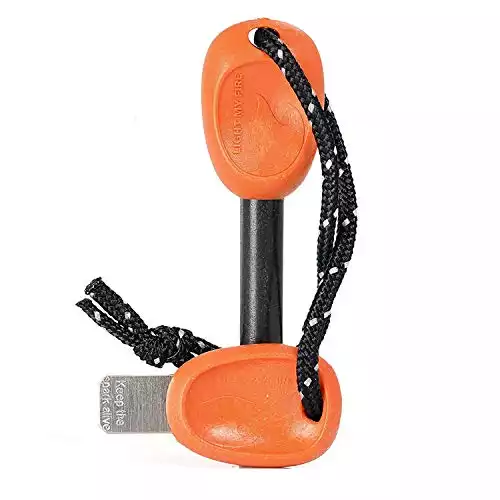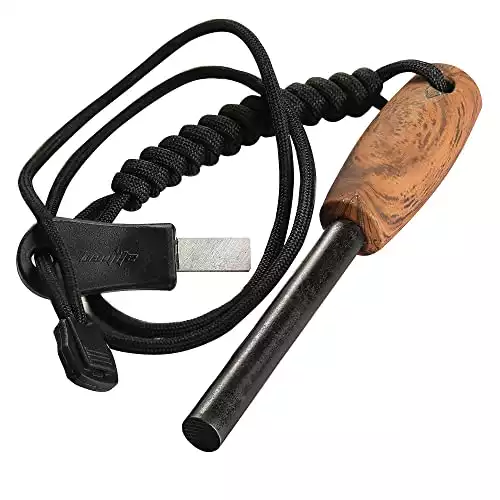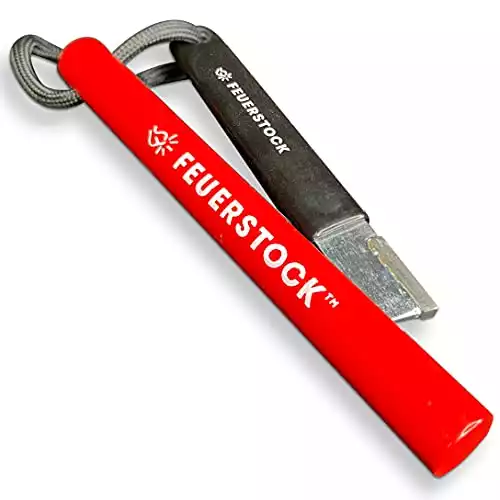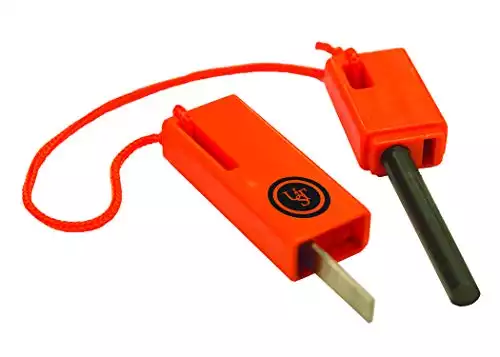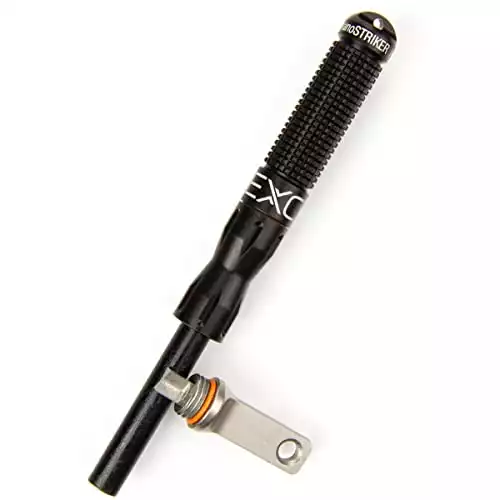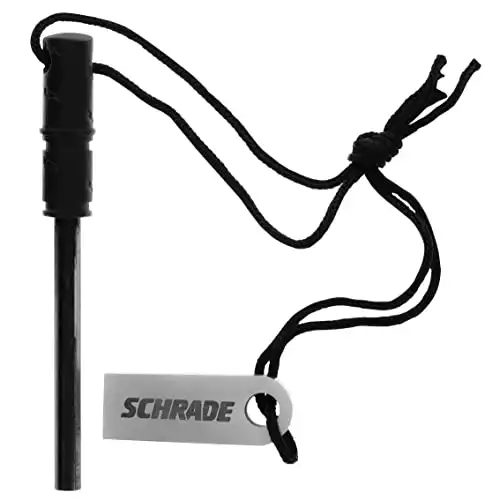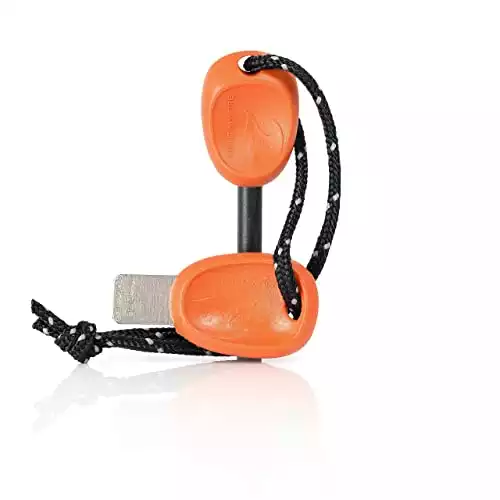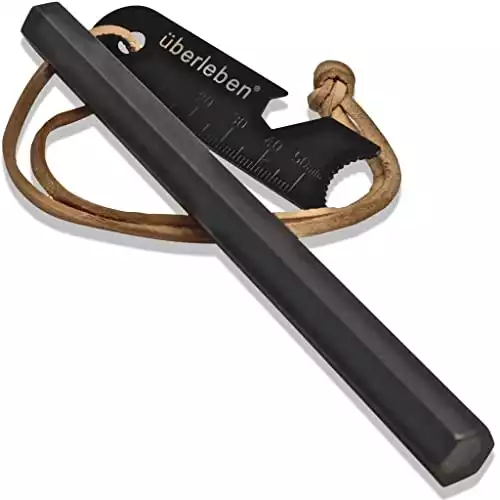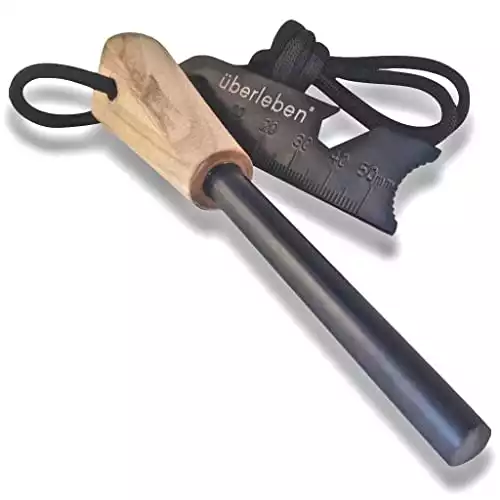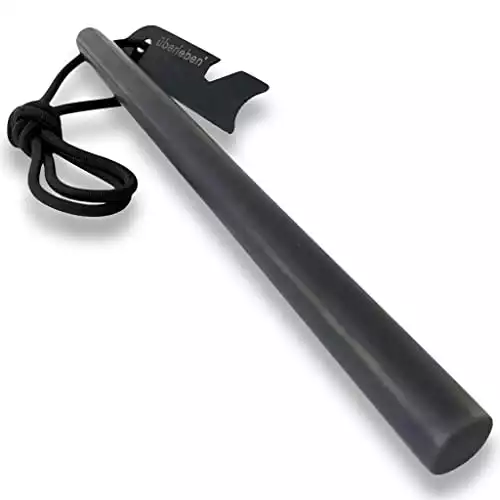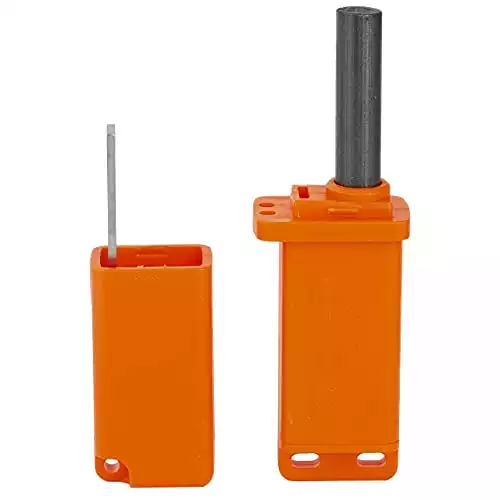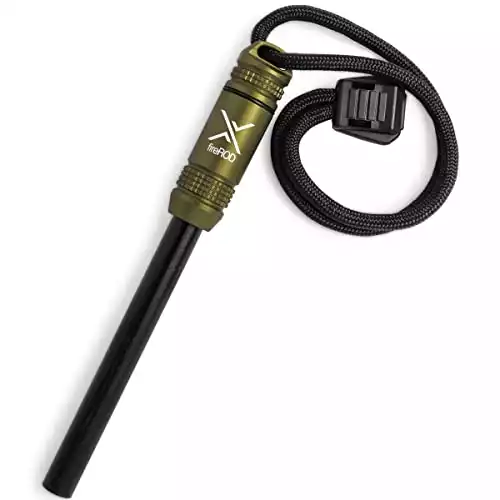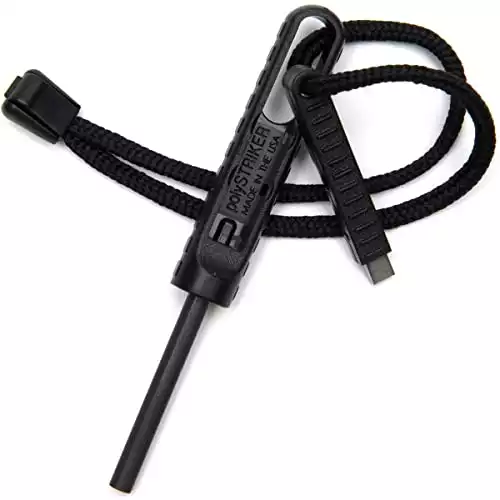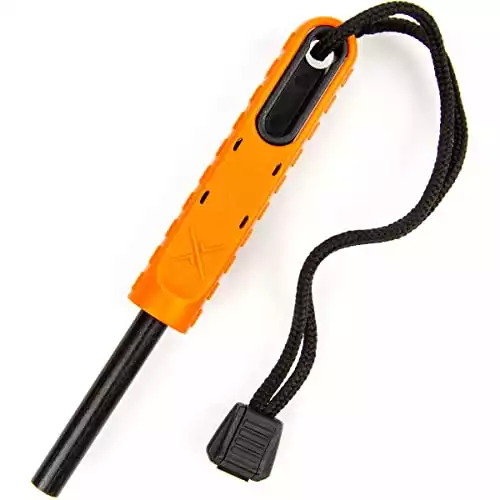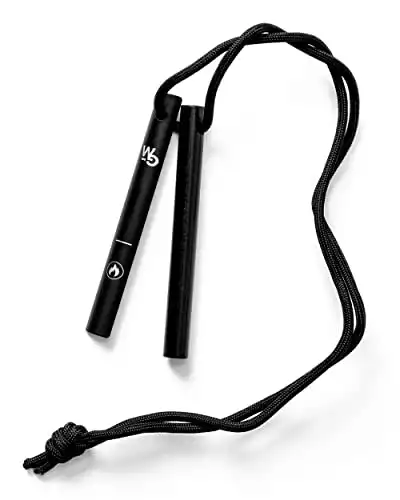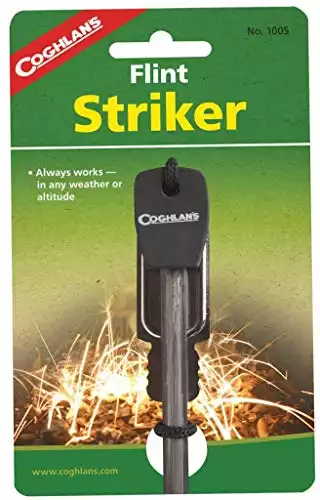Starting a fire is an essential survival skill. You’ll need it for signaling, warmth, purifying water, and much more.
While it is easier to use a Bic lighter to get a fire going, a ferro rod is great to have. With practice, it won’t let you down, and you don’t have to worry about it running out of fuel or failing on you like a lighter can.
But choosing a ferro rod can be a tedious process.
There are hundreds of options, and it’s hard to tell the difference between them.
Whether you are a beginner or a pro, here’s what you need to know to choose the best ferro rod for bushcraft, survival, or your Bug Out Bag – plus the top picks as tried and tested by real survivalists.
Also read:
- Expert Tips for Using a Ferro Rod
- Best Tinder for Ferro Rods
- 29 DIY Fire Starters (with burn test results)
Are All Ferro Rods The Same?
A lot of ferro rods are the exact same. The “makers” get the rods from the same Chinese wholesalers and put their brand name and maybe a handle or lanyard on them. The rest is just marketing.
However, this does not mean that all ferro rods are the same. Some brands take care to get their rods from higher-quality manufacturers so the rods and strikers do a better job producing hot sparks. In addition, the rod’s size, grip, striker design, and hardness really make a difference.
Bottom Line Upfont
Choose a ferro rod at least 2 inches long when just getting started. Ideally, get a hard rod (like the LMF Army) and a softer one (like the Exotac fireROD) and start playing.
Then you’ll be able to see which hardness you prefer and what works best with the type of tinder you use. And, because the striker matters so much, don’t forget to play with different strikers too!
Best Ferro Rod Comparison Table
|
Length:
2.2"
|
Length:
2", 4", 5", 6"
|
Length:
5"
|
Length:
1.65"
|
Length:
1.4"
|
Length:
2.3"
|
Length:
1.7"
|
Length:
3", 6"
|
Length:
2.75"
|
Length:
5", 8"
|
Length:
1.65"
|
Length:
2.4"
|
Length:
2"
|
Length:
2"
|
Length:
3.9"
|
Length:
2.9"
|
|
Diameter:
0.375"
|
Diameter:
0.3", 0.375", 0.5"
|
Diameter:
0.5"
|
Diameter:
0.25"
|
Diameter:
0.25"
|
Diameter:
0.25"
|
Diameter:
0.25"
|
Diameter:
0.5"
|
Diameter:
0.3", 0.375", 0.5"
|
Diameter:
0.5"
|
Diameter:
0.375"
|
Diameter:
0.3"
|
Diameter:
0.188"
|
Diameter:
0.3"
|
Diameter:
0.43"
|
Diameter:
0.3"
|
|
Hardness:
Hard
|
Hardness:
Hard
|
Hardness:
Hard
|
Hardness:
Medium
|
Hardness:
Soft
|
Hardness:
Medium
|
Hardness:
Hard
|
Hardness:
Medium-Hard
|
Hardness:
Medium-Hard
|
Hardness:
Medium-Hard
|
Hardness:
Medium
|
Hardness:
Soft
|
Hardness:
Soft
|
Hardness:
Soft
|
Hardness:
Hard
|
Hardness:
Soft
|
|
Rod Handle:
Plastic
|
Rod Handle:
Wood or none
|
Rod Handle:
None
|
Rod Handle:
Plastic
|
Rod Handle:
Aluminum
|
Rod Handle:
Plastic
|
Rod Handle:
Plastic
|
Rod Handle:
None
|
Rod Handle:
Wood
|
Rod Handle:
None
|
Rod Handle:
Plastic
|
Rod Handle:
Aluminum
|
Rod Handle:
Plastic
|
Rod Handle:
Plastic
|
Rod Handle:
None
|
Rod Handle:
Plastic
|
|
Striker:
Stainless steel with plastic grip
|
Striker:
High speed steel with plastic grip
|
Striker:
4" carbide with rubber handle
|
Striker:
0.75" steel with plastic handle
|
Striker:
Tungsten carbide with aluminum handle
|
Striker:
1.25" steel striker
|
Striker:
Stainless steel with plastic grip
|
Striker:
Y shaped multi-tool
|
Striker:
Y shaped multi-tool
|
Striker:
Y shaped multi-tool
|
Striker:
0.75" steel with plastic handle
|
Striker:
None
|
Striker:
Tungsten carbide with plastic handle
|
Striker:
Tungsten carbide with plastic handle
|
Striker:
3.9" steel with plastic handle
|
Striker:
2.75" striker
|
Best Ferro Rods, Reviewed
1. Light My Fire Scout and Army Ferro Rods
LMF is consistently listed as the best ferro rod. They really are well-made. If you’ve practiced using a cheap $2 ferro rod and switched to this, you’ll be surprised how easy it is to get a fire going with it.
There are two main options: the Scout and the Army. Both use a hard type of ferro which produces very hot sparks. The difference is in size – the Army is larger than the Scout rod. If you are new to ferro rods, I’d recommend getting the Army since it is larger and easier to use.
The striker that comes with the Light My Fire ferro rods is great. It has a concave indentation for your fingers, giving you a good grip. There are six hard-striking areas on the striker.
The grip is only concave on one side, though. So, unless you are ambidextrous, you must hold the striker in the same direction each time. This means you can only use one of the six striking surfaces: you’ll have to resharpen the striker sooner than if you could use all sides of it.
There’s a whistle built into the striker, which is pretty cool. The main downside is that the Light My Fire ferro rods are expensive compared to other options.
Pros:
- Very hard ferro rod
- Good grip on striker
- Made in Sweden
- Whistle on striker
Cons:
- Not the cheapest option
2. Bayite Survival
Aside from the price, the best thing about Bayite ferro rods is that there are so many options.
They come in sizes ranging from tiny 2-inch long rods (for use on paracord bracelets) to massive 6-inch rods, which are ½ inch thick. You can also choose between a wood handle or no handle for the ferro rod. There’s an option to get one with a paracord lanyard too.
The “Striker Pro” that comes with the Bayite rods is great. It has a plastic handle that is 1.7″ long and pretty broad, so it is glove-friendly.
The actual striking surface is about 0.7 inches long. It is made from a thick piece of metal with 6 edges. It’s pretty sharp and produces good sparks.
Unlike with the Light My Fire strikers, you can comfortably hold the striker in different directions to use a different edge.
The only bad thing about the Bayite ferro rods is that they aren’t the hardest (Light My Fire is harder), so the sparks aren’t as hot. But it’s still a good quality metal, especially considering it’s Chinese-made and cheap.
Pros:
- Many sizes and widths
- Various handle options
- Good grip on striker
- Striker has 6 striking surfaces
- Cheap
Cons:
- Not the hardest rod
3. Uberleben Ferro Rods
The main thing to love about Uberleben ferro rods is that they are longer and fatter than most others. This is great for cold weather survival situations, such as when wearing gloves.
There are three models of rods:
- Kraftig: It doesn’t have a handle but is very long, so you can put your own handle on it.
- Zunden: Has a nice wooden handle for an even better grip. Comes in multiple widths but only one length.
- Hexa: Hexagon shape makes it easier to strike.
All three Uberleben ferro rods use the same type of rod. The hardness falls between medium and hard, so you’ll get good sparks from these.
You’ll probably hate the cheap Y-type striker that comes with these ferro rods, though. It does have a little ruler and a bottle opener, but it is flimsy. The edge dulls down quickly, especially since you can only use one side.
Pros:
- Large sizes are good for learning and survival
- Lots of length and width options
- Wood handle option
- Glove-friendly
Cons:
- Overpriced
- Not the best striker
4. Feuerstock 5” Ferro Rod
This brand isn’t nearly as well-known as Uberleben, but they also make a great extra-large ferro rod.
I prefer it to the Uberleben for a lot of reasons.
The first is because it has an awesome striker with a rubberized grip. It’s very sharp and holds its edge well. The striker is just over 4″ long with the handle, so you get an excellent grip and control.
The ferro rod is very beefy at 5″ and ½” in diameter. It seems slightly softer (more magnesium) than the Light My Fire rod, so the sparks last longer.
I also love that they coated the ferro rod in red paint instead of black: it’s easier to find and tell which areas have had the coating fully removed.
Pros:
- Very sharp striker
- Rubber grip on striker
- Red coating on rod
Cons:
- Pricier option
5. UST Sparkforce and Strikeforce
Ferro rods will rust if exposed to moisture and acids. Once the protective coating has been removed, it’s not the best idea to carry them on keychains as part of your EDC. UTS solves this issue by putting their ferro rod in a plastic casing. The casing doubles as a handle, giving you an excellent grip.
The casing isn’t waterproof (it will leak if submerged in water), but it will keep the rod clean and dry. It also prevents the Ferro rod and striker from annoyingly dinging against each other as you walk.
I find the Strikeforce version too bulky to carry, but it does have an area for holding tinder. The smaller Sparkforce does not hold tinder.
Just note that the rods on these are short. Even with the good grip that the case provides, it can be difficult to get sparks on a short rod without experience.
Pros:
- Case protects against corrosion
- Glove-friendly
- Good grip
- Strikeforce case can hold tinder
- Striker and rod won’t ding against each other
- Cheap
Cons:
- Not waterproof
- Striker not the greatest
- Small rod
6. Exotac Ferro Rods
Exotac has some very cool-looking ferro rods, which are great for EDC. The ferro is a bit soft, but some people might prefer this. There are three main options:
- fireROD: This is just a rod – no striker is included. The standout feature is that the aluminum handle doubles as a waterproof storage compartment. It’s small but will fit enough tinder to get a fire going. The rod is also a decent length.
- polySTRIKE: The polySTRIKE is designed so the striker nests into the rod handle. It comes in two widths: 3/16 and 5/16. In both sizes, the exposed part of the rod is 2″. The striker is tiny but has a cool shape that makes it easy to use, especially since the grip is good. It’s pretty sharp.
- nanoSTRIKE XL: The nanoSTRIKE has a fantastic design that keeps the ferro rod inside the handle. The striker serves as a lid. The rod is small but replaceable if you use it up. It’s a bit pricey for a first ferro rod, though.
Pros:
- Good for EDC
- Made in the USA
- Cool features like tinder storage
- Aluminum handle
- Striker is shaped nicely
Cons:
- Exposed part of rod is short
- Soft ferro rod
- Some models are pricy
7. Wolf and Grizzly Ferro Rod
This ferro rod has a nice design: the striker bar is concave and nests perfectly into the ferro rod. It makes it look very elegant – it would be awesome if you want to carry it as a necklace (though I don’t recommend that because of corrosion).
The design also solves the problem of the rod and striker banging against each other and making noise as you walk.
The rod and striker are also a very nice length, so it’s suitable for beginners. It’s also suitable for gloves, though people with large hands might prefer a beefier handle.
Pros:
- Striker nests into rod
- Suitable for neck carry
- Long striker for good grip
Cons:
- Pricier option
- No handle
8. Schrade Delta Class Ferro Rod
If you prefer a medium-hardness ferro rod, the Schrade Delta Class is a good option. The rod is a nice length (2.3 inches), and the handle is approximately 1.7″. Even with gloves, it’s easy to get a good grip on it.
The issue is that the striker that comes with it is not very good. It is minimal (a bit longer than 1 inch) and hard to hold. While it is thick and has 6 striking sides, the edges wear down quickly. Only get this ferro rod if you plan on using your own striker.
Pros:
- Cheap
- Good length
- Glove friendly
Cons:
- Tiny striker hard to hold
- Striker loses edge quickly
9. Coghlan’s Flint Striker
This is probably the cheapest ferro rod you’ll find that still works. It’s much softer than most ferro rods, and you can even scrape off part of the rod to put it on top of your tinder.
The length of the rod is pretty good for beginners. I hate the striker that comes with the Coghlan’s rod, though. It is flimsy and bends easily. The edge isn’t very sharp and loses the little bit of sharpness it has quickly. You’ll definitely want a different striker to use with this.
Even if budget is your main concern, I’d recommend paying a few more dollars to get the Schrade ferro rod. But, if you learn with this absolute-cheapest option, you’ll be able to get a fire going with any better ferro rod!
Pros:
- Very cheap
- Good length
- Can use shavings on top of tinder
Cons:
- Terrible striker
How to Choose a Ferro Rod
The main things you want to look at when choosing a ferro rod are
- Size
- Grip
- Striker design
- Hardness level
Once you figure out your preferences for these things, you can start looking at additional features.
Ferro Rod Size
As a general rule, larger and wider ferro rods are easier to use. There are several reasons for this:
- The striker comes in contact with more material, so you get more sparks.
- It’s easier to grip a large ferro rod.
- You’ll be able to apply more force to the ferro rod, so more material will be removed and spark with each strike.
Dave Canterbury of the Pathfinder survival school recommends getting a 6″ long and ½” diameter ferro rod. A ferro rod this large is going to be a lot more reliable for getting a fire going.
But large ferro rods are heavy and bulky. For everyday carry – such as on a keychain — most people will choose a smaller ferro rod that is 2″ or shorter in length.
Tip: Remember to look at the length of the exposed part of the ferro rod and not the length of the entire rod with the handle.
Grip
I don’t think the handle on a ferro rod matters very much. The handles on cheap ferro rods will just fall off eventually, anyway. If the ferro rod is long enough, you can wrap some duct tape around the top to make your own handle. Or, if you are crafty, you can make your own wooden handle for the ferro rod.
However, what matters is the grip on the ferro rod and striker.
Imagine if you need to use the ferro rod with frozen hands. Or with gloves on. Without a good grip, it can be challenging to get sparks!
For grip, I prefer the small plastic handles with a concave indentation for your thumb (like the one on the Light My Fire ferro rods and strikers).
I hate bare metal strikers (like the Coghlan’s striker). When I was just learning to use ferro rods (and had to strike them a few times before getting a fire going), I got blisters from where the metal was digging into my fingers! These strikers are NOT fun to learn with!!!
Striker Design
You’ll quickly realize that the striker included on most ferro rods is terrible quality. They are often difficult to grip, too soft or flexible to push into the ferro rod (you need friction to get sparks!), and they lose their sharp edge quickly.
A few brands do include decent strikers with the ferro rods. The Feuerstock striker is fantastic. The Light My Fire and Bayite strikers are pretty easy to grip, considering their small size.
But any hard metallic object with a sharp edge will work as a striker. It doesn’t have to be metal – broken glass and ceramic can work too. You just need something easy to grip. Below are some of the best alternatives to strikers for ferro rods.
Also read: Striker Alternatives for Ferro Rods
Hardness Level
Ferrocerium is a manufactured metal alloy. Originally it was made from iron (Ferrum) and cerium – hence the name. Now, numerous other metals are added to the alloy to produce larger, hotter sparks.
But, unless you are a metallurgist, which metals are in the ferro rod probably won’t mean anything to you. Manufacturers rarely give out this info anyway.
Instead, you should look at the hardness of the ferro rod.
The hardness is what survivalists are referring to when they say that one ferro rod “throws hotter sparks” than another.
- Harder Rods: These contain less magnesium. They produce fewer and smaller sparks but are hotter and last longer.
- Softer Rods: Also sometimes called mischmetal, these contain more magnesium. Instead of sparks, they rain “gobs of molten burning metal” on your tinder. These gobs aren’t as hot or long-lasting as with a harder ferro rod.
Which is better? It’s a matter of personal preference. I’d recommend getting a hard and soft ferro rod and seeing which you like better.
Note about the Longevity of Ferro Rods: Because less material is removed with each strike, harder ferro rods will last longer than softer rods. I wouldn’t worry about this unless you use your ferro rod multiple times daily. Since ferro rods are cheap, longevity shouldn’t be a deciding factor – and even a soft rod will still last for thousands of strikes.
Additional Features
- Carry method: Most ferro rods have a lanyard hole, so you can put it on a keychain, necklace, etc. Some have multiple holes so that you can put them on paracord bracelets.
- Sawtooth striker: The striker included in some ferro rods has a saw tooth. This is for scraping magnesium shavings off the rod to help get your fire going. It can also be used for scraping tinder, though a knife works much better.
- Storage capsule: The handle on some ferro rods doubles as a storage container for tinder.
- Carry Case: A few brands have cases for their ferro rods. This helps protect the ferro rod from moisture and corrosion.
- Compass in handle: This is incredibly gimmicky, but I guess some people would like this feature.
Pro Tip: If you keep a ferro rod in your survival or Bug Out Bag (and won’t use it for a while!), coat it with nail polish. This will prevent corrosion.

